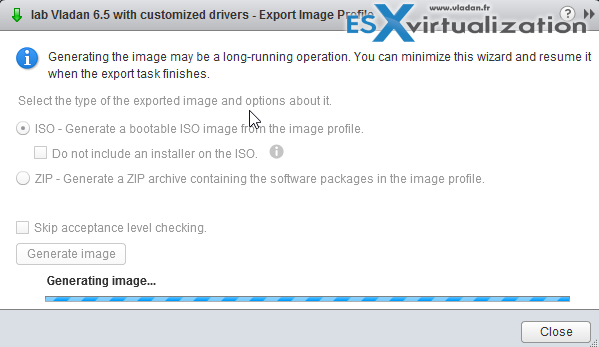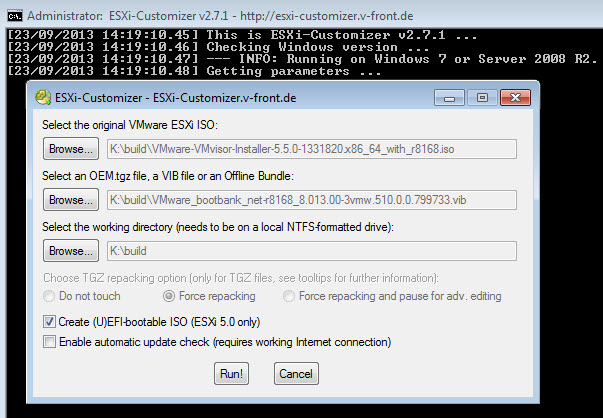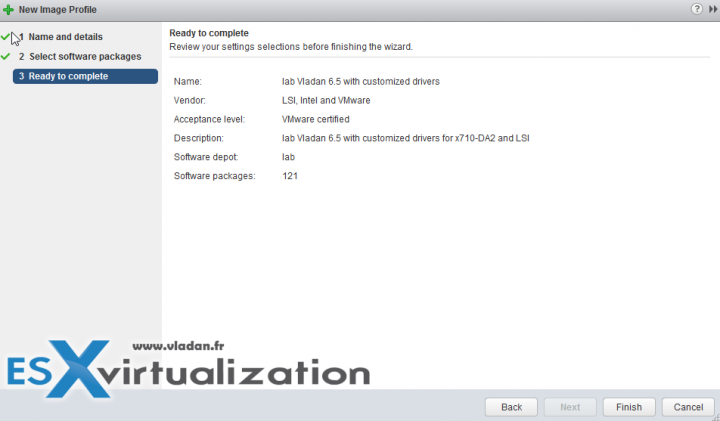Add Drivers To Esxi 6 Iso
How to add Intel NIC drivers to an ESXi 5.5 ISO. Posted on January 4. The hardware compatibility guide shows both of these nics as having drivers in esxi 6, yet. Jan 31, 2018 - Starting with vSphere 6.5, it is now possible to customize ESXi ISO. 6.5 ISO image and add to it the latest patches, updates, and drivers. In our case, we select the ISO option (5) and click on the Generate Image (6) button.
- Export Vm From Vmware Workstation 12 To Esxi 6
- Vmware Esxi 6 Iso Download
- Adding Realtek R8168 Driver To Esxi 6 Iso
This is a basic overview document, highlighting the steps that I walk you right through in the accompanying video below. The video features my live recording done on the very day vSphere 6.7 was announced and released, so it's a bit rough around the edges and completely unrehearsed. All that aside, I'm delighted to say that it went well. Like, really well. The Xeon D-1500's included Intel I350 1GbE RJ45 network connections seems to work fine, and for the first time ever, the Xeon D-1500's Intel X552/X557 10GbE RJ45 network connections seem to work fine as well. Even better, as I was promised months ago, the fix for the inaccurate RPM and temperature readings has been incorporated too, no more kludgey 'fix'!
Following along, you will learn some stuff even if you've done this before, as I do my usual voice-over, and side-step any dependencies on crummy Java for the Out of Band Management / iKVM install using just HTML5 and a network share.
The install and initial configuration procedure for ESXi has always been quite straight forward, but this detailed step-by-step will be extra helpful if you've never installed ESXi recently, and/or it's your your first time using the HTML5 iKVM and the vSphere Host Client, which is also HTML5.
Cautiously optimistic, but by far the easiest install yet!
SuperServer Bundles owners aren't likely to be asking me questions about how to install ESXi 6.7 on this system because it's now become quite simple, and this is great! The days of fiddling with CDs and DVDs burners are well behind us, let's just hope the X557 woes that some 12 core Xeon D owners experience, myself included, are also behind us. Only time, and a whole lot more Tinkering will tell! The next system I'll be test upgrading is my expermental Xeon D-1567 SuperServer Workstation that I use as my primary system, used to write hundreds of articles and videos, like this one, and to run vSphere, simultaneously.
You should keep in mind that this is just day one, release day. It could be a while before we see what network driver & firmware combination is recommended for this system, and which solid VM backup solutions offers full compatibility. So this is really just an initial test. I'll add updates below this article.
Prerequisites
- a workstation or laptop with a browser and an OS, such as Linux or Windows
- a Supermicro SuperServer with an Intel Xeon D-1500 processor, such as the Xeon D-1540 based SYS-5028D-TN4T Bundle 2 featured in the video below
- the ISO file you'll be using to install from, already downloaded from VMware, as explained here, with the one file you need,
VMware-VMvisor-Installer-6.7.0-8169922.x86_64.iso
as featured in the video below - a USB thumb drive to install to, such as the SanDisk Ultra Fit featured in the video below, included with any SuperServer Bundle
- at least one available hard drive or SSD, for VMware's VMFS filesystem where your VMs will live, such as an insanely fast Samsung 950 M.2 NVMe SSD
Stuff that's not required
since you have that nifty IPMI management feature, you don't need
- a monitor attached directly to the server
- a keyboard attached directly to the server
- a mouse attached directly to the server, see also
Little secret those new to virtualization often miss - ESXi 6.0 continues to be mostly headless, just as it was for all prior VMware hypervisor releases
Step-by-step
- use your browser to connect to your SuperServer's IPMI management features using your browser (the IP address that you point your browser to is displayed if you temporarily connect a VGA monitor, shortly after power on)
- launch the Remote Console feature, aka, iKVM, but use the HTML5 iKVM and follow along at my detailed article, How to map a network share to boot from ISO, moving Supermicro Java iKVM to browser-only HTML5 iKVM.
- enter BIOS Configuration and configure it for UEFI, as described in detail here, note, if you bought a SuperServer Bundle, you can skip this step, since you have a turn-key solution that's ready for ESXi as-is
- click the Power Control to restart the server
- press F11 to invoke Boot Menu
- from the Please select boot device menu, select UEFI: SanDisk then press Enter
- proceed with a normal ESX installation
- from the Select a Disk to Install or Upgrade menu, choose
SanDisk Ultra Fit (mpx.vmhba32:C0:T0:L0) (or similar) - when prompted to Remove the installation disc before rebooting, click the iKVM Virtual Media / Virtual Storage menu option, then click the Plug Out button then click OK
- you may now hit Enter to Reboot
- once the newly installed ESXi is booted off USB, it will show you the hostname or IP address that you can point your browser to, then type root and the password you configured during install
- now that you're authenticated, click on the Open the VMware Host Client seen at the top left of the VMware ESXi Welcome page, which launches the new HTML5 interface of VMware's future, all the basic features needed to format a datastore and create your first VMs are there for you
The rest of the video goes through me setting up the clock/NTP.
Export Vm From Vmware Workstation 12 To Esxi 6
VCSA install and configuration is more involved, and will need to wait for another day.

Step-by-step Video
Apr 18 2018 Update
Note that the popular Supermicro SuperServer SYS-5028D-TN4T is on the VMware Compatibility Guide for 6.7 already, very nice! A lot faster than it took to get 6.5 listed ;), which is a good thing, a very good thing.

See also an interesting conversation here at TinkerTry, talking about CBT and backup products like Veeam and NAKIVO vSphere 6.7 readiness.
May 09 2018 Update
I managed to not mention that the awesomeness of not having to use Oracle Java or Adobe Flash for any aspect of bringing vSphere 6.7 up in your home lab. This is something we've all been waiting for, and the news gets even better soon!
- Fully Featured HTML5-based vSphere Client Coming in Fall 2018
by Himanshu Singh at VMware vSphere BlogThe vSphere Client is a tool you use every day to manage your virtual infrastructure. You’ve told us what you want to see improved and that you want progress to be prioritized. We’ve been listening and acting on your feedback and we’d like to share the progress that’s been made, as well as our plans moving forward.
Many of you have been asking when will the vSphere Client become fully featured. We are targeting to deliver to you a fully featured version of the vSphere Client later this year, in Fall 2018.
See also at TinkerTry

- How to easily update your VMware ESXi Hypervisor to the latest version with one ESXCLI command
Aug 14 2018
Vmware Esxi 6 Iso Download
- Supermicro Xeon D SuperServer BIOS 2.0 and IPMI 3.68 released
Aug 09 2018
- USB Image Tool for Windows easily backs up and restores your complete VMware ESXi hypervisor on USB or SD flash drives, a simple/free clone for peace of mind before patching or upgrading
Jun 14 2018
Adding Realtek R8168 Driver To Esxi 6 Iso
- VMware vSphere 6.7 announced today, here's how to download it right away
Apr 17 2018
- VMware vSphere 6.7 featuring vSAN 6.7 released!
Apr 17 2018